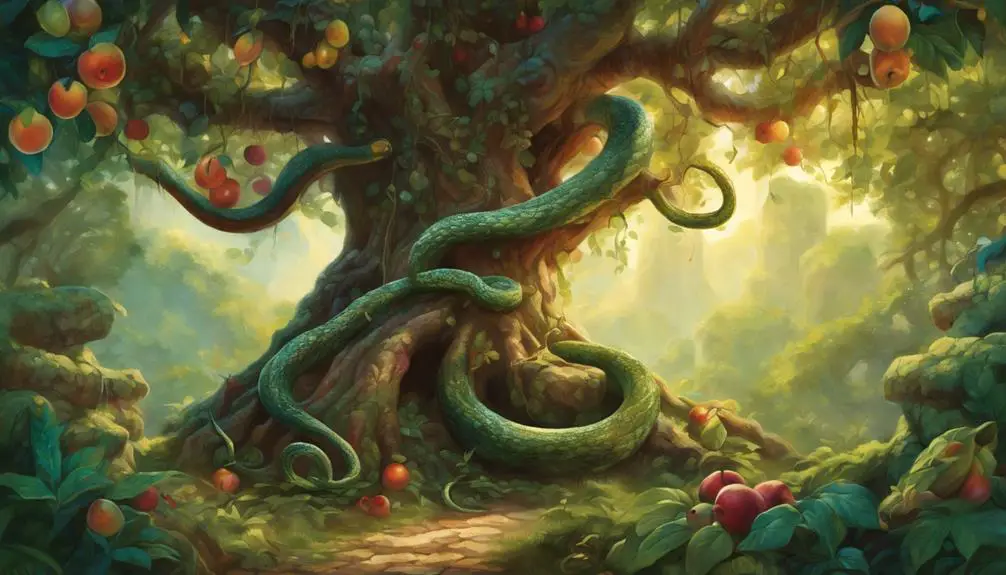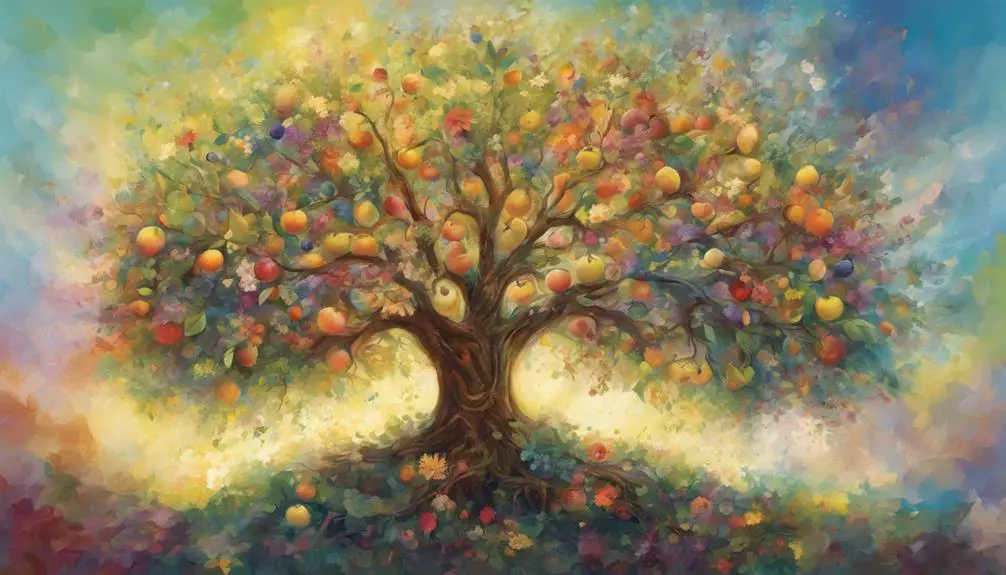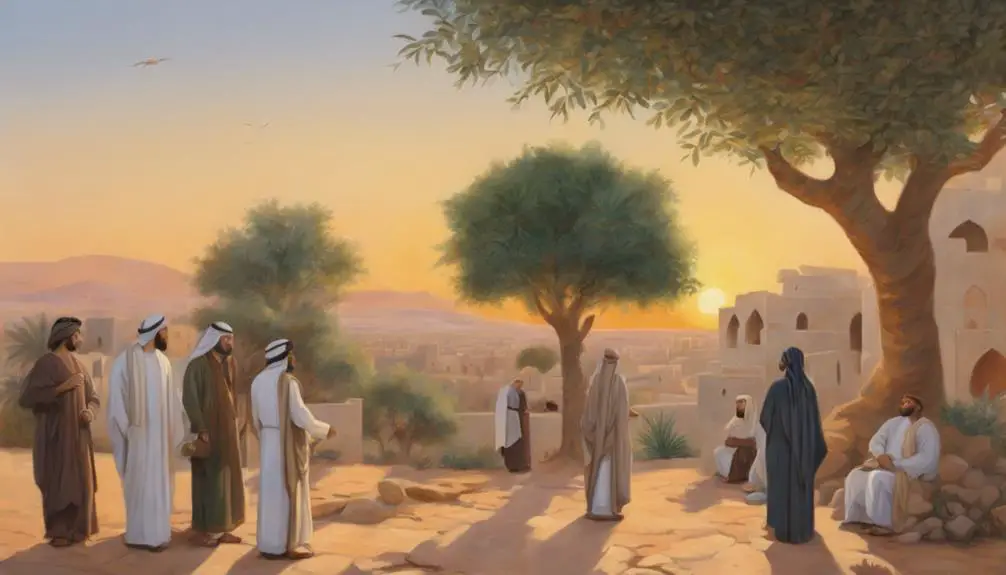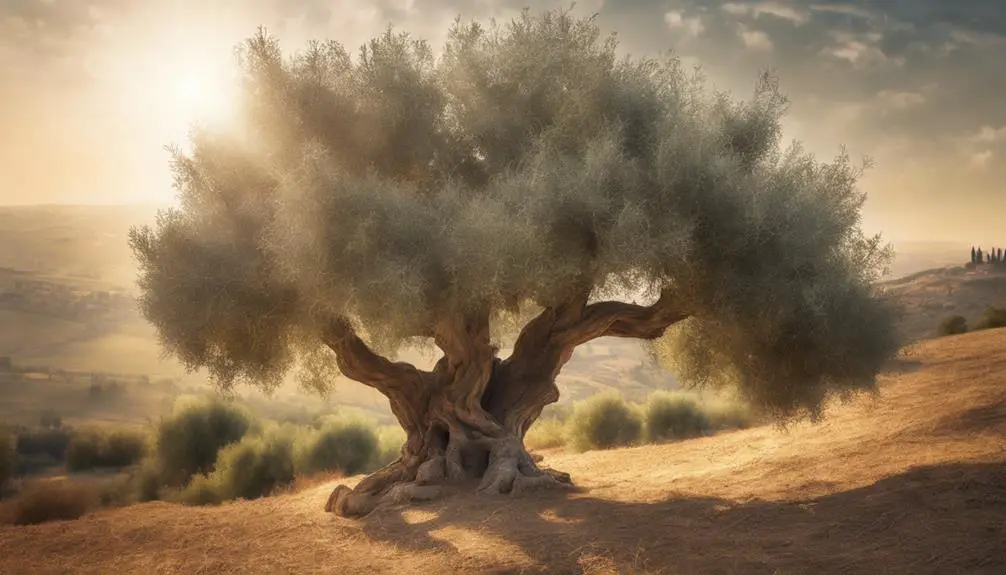Kneel into the verdant tales of Biblical trees to unearth spiritual symbols and divine messages hidden in their branches.

Tree in the Bible
Just as the Tree of Knowledge stood at the center of Eden, trees have rooted themselves deeply within Biblical narratives, offering not only literal shade but also metaphorical lessons. You'll find that from the Cedars of Lebanon to the parables of the Fig Tree, each serves a unique purpose in conveying messages of wisdom, judgement, and redemption.
The Burning Bush and Olive Trees further enrich this tapestry, symbolizing divine presence and peace. Unraveling these stories, you'll uncover layers of meaning that could transform your understanding of biblical teachings, inviting you to explore a forest of spiritual insights waiting just beyond the surface.
Key Takeaways
- Trees in the Bible symbolize crucial spiritual concepts such as life, knowledge, and divine presence.
- The olive tree represents peace, hope, resilience, and the sacred in religious practices.
- Parables involving trees like the fig tree teach lessons about spiritual growth, patience, and divine judgment.
- The enduring nature of trees like the Cedars of Lebanon and olive trees reflect themes of strength, permanence, and divine beauty.
The Tree of Knowledge

In the biblical narrative of Genesis, the Tree of Knowledge stands as a pivotal symbol of the complex interplay between divine command and human free will, inviting readers to explore the intricate dynamics of obedience, temptation, and consequence. This tree, bearing the forbidden fruit, becomes the focal point of humanity's inaugural moral test. The Serpent's temptation represents not merely a challenge to divine authority but also underscores the inherent vulnerability and curiosity of human nature.
You're drawn into a narrative where the consumption of the forbidden fruit emerges as a metaphor for the acquisition of experiential knowledge, marking the transition from innocence to the awareness of good and evil. This act of disobedience, while leading to the fall of man, paradoxically opens the door to human consciousness and moral discernment. The Tree of Knowledge, therefore, embodies the profound and often perilous journey towards self-awareness and autonomy.
Analyzing this story, you'll find that it's not just about the consequences of disobedience but also about a divine setup for human growth. The Serpent's temptation and the forbidden fruit serve as catalysts for this inevitable evolution, framing the Tree of Knowledge as a crucial element in the divine-human relationship.
The Tree of Life

Parallel to the Tree of Knowledge, the Tree of Life stands as another profound symbol within the biblical narrative, offering insights into the eternal nature of God's provision and the potential for human access to everlasting life. This emblematic tree, deeply rooted in Garden symbolism, underscores the interconnectedness of life and the divine. Its presence in Eden highlights a path to Eternal life, symbolizing both divine benevolence and the profound responsibility bestowed upon humanity.
Symbol Aspect |
Interpretation |
|---|---|
Garden Setting |
Represents an idyllic, divine order where humans and God coexist. |
Eternal Life |
Emphasizes the possibility of transcending mortal limits through faith and obedience. |
Divine Provision |
Suggests that sustenance and life are gifts from God, requiring stewardship and respect. |
You're invited to ponder the duality of the Trees of Knowledge and Life. They're not just historical or mythical symbols; they echo the ongoing human quest for wisdom and immortality, framing the narrative of humanity's relationship with the divine. As you delve deeper into the biblical texts, consider how these trees reflect your understanding of Garden symbolism and the concept of Eternal life, shaping your perception of spiritual and moral landscapes.
Cedars of Lebanon

The majestic Cedars of Lebanon, celebrated throughout biblical scripture, embody strength, permanence, and divine beauty, capturing the awe of those who encounter them. These ancient trees haven't only stood the test of time but have also been deeply embedded within the cultural and religious fabric of the region, symbolizing resilience and eternal beauty. Cedar symbolism in the Bible is multifaceted, representing purity, protection, and wisdom.
Historically, these trees were highly sought after for their durable and fragrant wood, leading to extensive historical harvesting by various civilizations, including the Egyptians and Phoenicians, for building temples, palaces, and ships.
To understand their significance, consider the following imagery:
- Towering Cedars, with their broad trunks and expansive branches, reaching towards the heavens as if in prayer.
- The scent of Cedar wood, rich and earthy, symbolizing cleanliness and divine protection.
- The sound of the wind through the Cedar boughs, a reminder of the eternal voice of the divine, whispering across centuries.
Analyzing the Cedars of Lebanon through this scholarly lens helps us appreciate not only their physical grandeur but also their profound spiritual and historical significance.
The Fig Tree Parables

Shifting focus from the towering Cedars of Lebanon, let's now examine the Fig Tree Parables, which offer rich insights into spiritual growth and divine judgment within biblical narratives. These parables, woven into the fabric of Scripture, employ the fig tree as a potent symbol, deeply rooted in the seasonal rhythms and agricultural practices of ancient times.
You'll notice that the fig tree's cycle of fruit-bearing isn't just an agricultural observation; it's a masterful piece of seasonal symbolism. The tree's progression from barrenness to fruitfulness parallels the spiritual journey of individuals and communities, highlighting themes of patience, persistence, and eventual reward. In these narratives, the absence of figs can symbolize spiritual barrenness, serving as a divine critique of complacency and a call to fruitful living.
Moreover, the attention to detail in describing agricultural practices around fig cultivation underscores the importance of nurturing one's faith and the consequences of neglect. These parables teach that just as a fig tree requires attention and care to yield fruit, so too does one's spiritual life require diligence and commitment.
Through the lens of the Fig Tree Parables, you're invited to reflect on the seasons of your own life, understanding that growth and judgment are as natural to the spirit as they're to the earth.
The Burning Bush

In an iconic narrative within the biblical text, God reveals Himself to Moses through a bush that burns without being consumed, offering profound insights into divine presence and guidance. This moment is pivotal not only for its miraculous nature but also for its deep theological implications regarding divine communication and human response to it. You'll find that Moses' hesitation to accept his mission is met with a patient and instructive response from God, demonstrating a key aspect of divine-human interaction.
Consider these three elements to fully appreciate the scene:
- The Bush itself, ablaze yet not destroyed, symbolizes the enduring and purifying presence of God.
- Moses' Reaction captures a mix of awe, fear, and doubt, reflecting humanity's complex response to divine callings.
- The Voice from the bush, commanding yet reassuring, initiates a dialogue that shapes the course of biblical history.
This event encapsulates a profound lesson in faith, obedience, and the nature of divine communication. Moses' initial hesitation, confronted with the undeniable reality of God's presence, evolves into a transformative journey of trust and leadership. Analyzing this passage, you're invited to delve into the nuances of how God communicates with humanity and the responses that such encounters evoke.
Olive Trees in Scripture

Exploring another significant botanical symbol within the biblical narrative, olive trees emerge as multifaceted symbols of peace, anointing, and resilience. The olive harvest, a meticulous process, not only provided sustenance in the form of oil and food but also played a pivotal role in religious and ceremonial practices. This meticulous process underscores the olive tree's value and the labor invested to reap its benefits.
Olive oil, derived from this painstakingly gathered harvest, was used for anointing priests and kings, signifying sanctification and consecration to God's service. This act of anointing elevates the olive beyond its material value, embedding it with spiritual significance. The resilience of olive trees, capable of surviving and bearing fruit even in harsh conditions, further mirrors the enduring faith of those who follow God's path, despite adversity.
Moreover, the olive branch as a symbol of peace has its roots deep in scriptural narratives. The most iconic imagery perhaps comes from the story of Noah's ark, where a dove returns with an olive leaf, signaling the end of the flood and God's peace with mankind. This peace symbolism extends beyond mere tranquility, embodying hope, renewal, and a covenant of grace between the divine and humanity.
Frequently Asked Questions
How Is the Teil Tree Symbolically Used in Other Biblical Narratives Outside the Commonly Discussed Stories?
You won't find explicit references to the teil tree in many biblical narratives. However, its symbolism, especially regarding resilience, weaves through various scriptures.
Teil tree metaphors embody endurance and strength in adversity, reflecting a deeper, spiritual resilience. Such symbolic resilience is pivotal in understanding the broader themes of perseverance and faith across biblical texts.
Analyzing these subtler references offers a richer insight into the narrative's intricate layers and the symbolic language used throughout.
Are There Any Lesser-Known Parables or Teachings in the Bible Where the Teil Tree Plays a Significant Role?
Diving into the depths of biblical narratives, you'll find that the teil tree, though not spotlighted in mainstream stories, holds its ground in lesser-known teachings. Its preservation and modern symbolism weave through parables with subtlety, illustrating resilience and spiritual growth.
Analytically speaking, this tree's role, albeit understated, enriches the fabric of biblical symbolism, offering layers of interpretation that underscore its significance beyond ornamental value in ancient texts.
How Do Biblical Scholars Interpret the Significance of the Teil Tree in the Cultural and Religious Context of Ancient Times?
You're diving into how scholars dissect the importance of certain trees in ancient cultures and religions.
The focus on tree identification sparks scholarly debates, uncovering layers of meaning and symbolism.
Researchers meticulously analyze texts, comparing them to archaeological findings and historical accounts.
This deep dive reveals not just a tree's religious significance but also its role in everyday life, offering insights into the beliefs and practices of ancient communities.
What Are the Historical Uses of Teil Trees in Daily Life and Religious Ceremonies in Biblical Times?
You're walking through history, uncovering the layers of daily life and religious practices where teil trees stood as silent witnesses. Their botany played a crucial role, from providing shade and lumber to being integral in rituals.
Drawing parallels to modern uses, it's like seeing ancient practices in today's green spaces and spiritual observances. Delving into the historical backdrop, you analyze how these trees interwove with the fabric of society, echoing their significance across time.
How Does the Depiction of the Teil Tree in the Bible Compare to Its Portrayal in Other Ancient Texts and Traditions?
You're exploring how ancient texts and traditions portray the teil tree, focusing on ancient comparisons and cultural symbolism.
Unlike its specific biblical depiction, other ancient narratives might highlight its symbolic or practical roles differently. Analyzing these variations reveals the tree's multifaceted significance across cultures.
This scholarly approach uncovers nuanced insights into its historical uses and religious symbolism, offering a detailed understanding of its broader cultural impact beyond biblical references.
Conclusion
In conclusion, the trees in the Bible aren't just background scenery; they're deeply rooted in the narrative soil, bearing fruits of wisdom, life, and spiritual nourishment.
From the Tree of Knowledge, which opened the floodgates of human consciousness, to the steadfast Cedars of Lebanon symbolizing strength, these arboreal symbols weave a rich tapestry of lessons and parables.
Like leaves on a vast, ancient tree, each story contributes to the overarching canopy of spiritual heritage, shading and shaping the human experience with divine whispers.



Sign up